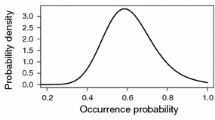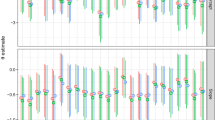Summary
The multiple decrement life table is used widely in the human actuarial literature and provides statistical expressions for mortality in three different forms: i) the life table from all causes-of-death combined; ii) the life table disaggregated into selected cause-of-death categories; and iii) the life table with particular causes and combinations of causes eliminated. The purpose of this paper is to introduce the multiple decrement life table to the ecological literature by applying the methods to published death-by-cause information on Rhagoletis pomonella. Interrelations between the current approach and conventional tools used in basic and applied ecology are discussed including the conventional life table, Key Factor Analysis and Abbott's Correction used in toxicological bioassay.
Similar content being viewed by others
References
Abbott WS (1925) A method of computing the effectiveness of an insecticide. J Econ Entomol 18:265–267
Anon (1962) Vital Statistics Instruction Manual. Part II. Procedures for Coding Multiple Causes of Deaths Occuring in 1955. National Office of Vital Statistics, Washington, D.C.
Arnold RA (1983) Ecological studies of six endangered butterflies (Lepidoptera, Lycaenidae): island biography, patch dynamics, and the design of habitat preserves. University of California Press, Berkeley p 161
Batten RW (1987) Mortality Table Construction. Prentice-Hall, Inc., Englewood Cliffs, New Jersey
Bosch R van den, Messenger PS (1973) Biological Control. Intext Educational Publishers, New York p 180
Cameron PJ, Morrison FO (1977) Analysis of mortality in the apple maggot, Rhagoletis pomonella (Diptera: Tephritidae), in Quebec. Can Entomol 109:769–788
Carey JR (1986) Interrelations and applications of mathematical demography to selected problems in fruit fly management. In: Pest Control, Mangel M, Carey J, Plant R (eds) Operations and Systems Analysis in Fruit Fly Management. Springer, Berlin Heidelberg New York pp 227–262
Carey JR (1988) Demographic approaches to specified problems in fruit fly management. In: Vijaysegaran S (ed) Fruit Flies in the Tropics. Proc. Inter. Symposium, March, 1988. Kuala Lumpur, Malaysia (in press)
Chiang CL (1984) The Life Table and its Applications. Robert E. Krieger Publishing Co, Malabar, Florida
DeBach P, Huffaker CB (1971) Experimental techniques for evaluation of the effectiveness of natural enemies. In: Huffaker CB (ed.) Biological Control. Plenum Press, New York pp 113–140
Deevey ES Jr (1947) Life table for natural populations of animals. Quart Rev Biol 22:283–314
Elandt-Johnson RC, Johnson NL (1980) Survival Models and Data Analysis, John Wiley and Sons, New York
Farr W (1875) Effect of the extinction of any single disease on the duration of life. Suppl. 35th Ann Rep Registrar General 21:38
Finney KJ (1964) Probit Analysis. Cambridge University Press, Cambridge p 318
Greville RNE (1948) Mortality tables analyzed by cause of death. The Record Amer Inst Actuaries. 37. Part II. No. 76
Harcourt DG (1969) The development and use of life tables in the study of natural insect populations. Ann Rev Entomol 14:175–196
Harcourt DG (1971) Population dynamics of Leptinotarsa decemlineata (Say) in eastern Ontario. III. Major population processes. Can Entomol 103:1049–1061
Hewlett PS, Plackett RL (1959) A unified theory for quantal responses to mixtures of drugs: non-interactive action. Biometrics 15:591–610
Hewlett PS, Plackett RL (1961) Models for quantal responses to mixtures of two drugs. In: DeJonge H (ed.) Quantitative Methods in Pharmacology. North-Holland, Amsterdam. pp 329–336
Hewlett PS, Plackett RL (1964) A unified theory for quantal responses to mixtures of drugs: competitive action. Biometrics 20:566–575
Huffaker CB, Kennett CE (1965) Ecological aspects of control of olive scale Parlatoria oleae (Colvee) by natural enemies in California. Proceedings of the XII International Congress of Entomology 585–586
Huffaker CB, Kennett CE (1966) Studies of two parasites of olive scale, Parlatoria oleae (Colvee). IV. Biological control of Parlatoria oleae (Colvee) through the compensatory action of two introduced parasites. Hilgardia 37:283–335
Keyfitz N (1982) Mathematical demography. In: JA Ross, (ed.) International Encyclopedia of Population. Free Press, New York. pp 437–443
Keyfitz N (1985) Applied Mathematical. Demography (2nd ed.) Springer, Berlin Heidelberg New York p 441
Kitagawa EW (1977) On mortality. Demography 14:381–389
Knipling E, McGuire JU Jr (1968) Population models to appraise the limitations and potentialities of “Trichogramma” in managing host insect populations. US Dept Agr Tech Bull 1387 p 44
Krall JM, Hickman JC (1971) Adjusting multiple-decrement tables. Transact Soc Act 22:163–179
Luck RR, Shepard BM, Kenmore PE (1988) Experimental methods for evaluating arthropod natural enemies. Ann Rev Entomol 33:367–391
Moriyama IM (1956) Development of the present concept of cause of death. Am J Publ Health 46:436–441
Morris RF (1959) Single-factor analysis in population dynamics. Ecology 40:580–588
Morris RF (1965) Contemporaneous mortality factors in population dynamics. Can Entomol 97:1173–1184
Namboodiri K, Suchindran CM (1987) Life Table Techniques and Their Applications. Academic Press, Inc., Orlando
Preston SH, Keyfitz N, Schoen R (1972) Cause of death: life tables for national populations. Seminar Press, New York
Robertson JL, Smith KC (1984) Joint action of pyrethroids with organophosphorus and carbamate insecticides applied to western spruce budworm (Lepidoptera: Tortricidae). J. Econ Entomol 77:16–22
Robertson JL, Smith KC, Granett J, Retnakaran A (1984) Joint action of a juvenile hormone analogue with benzoylphenylureas ingested by western spruce budworm, Choristoneura occidentalis (Lepidoptera: Tortricidae). Can Entomol 116:1063–1068
Royama T (1981a) Fundamental concepts and methodology for the analysis of animal population dynamics, with particular reference to univoltine species. Ecol Monogr 51:473–493
Royama T (1981b) Evaluation of mortality factors in insect life table analysis. Ecol Monogr 51:495–505
Royama T (1984) Population dynamics of the spruce budworm, Choristoneura funiferana. Ecol Monogr 54:429–462
Schoen R (1975) Constructing increment-decrement life tables. Demography 12:313–324
Shryock HS, Siegel JS, Stockwell EG (1976) The Methods and Materials of Demography. Academic Press, New York
Southwood TRE (1971) Ecological Methods (3rd ed.) Chapman and Hall, London
Sturm MM, Sterling WL (1986) Boll weevil mortality factors within flower buds of cotton. Bull Entomol Soc Am 32:239–247
Sun Y, Johnson ER (1960) Analysis of joint action of insecticides against house flies. J Econ Entomol 53:887–892
Thompson WR (1955) Mortality factors acting in sequence. Can Entomol 87:264–275
Van Driesche RG (1983) Meaning of “percent parasitism” in studies of insect parasitoids. Environ Entomol 12:1611–1622
Varley, GC (1947) The natural control of population balance in the knapweed gall-fly (Urophora jacenana). J Anim Ecol 16:139–187
Varley GC, Gradwell GR, Hassel MP (1973) Insect Population Ecology. University of California Press, Berkeley p 212
Vaupel JW, Yashin AI (1985) Heterogeneity's ruses: some surprizing effects of selection on population dynamics. Am Statist 39:176–185
Vaupel JW, Yashin AI (1987) Repeated resuscitation: how lifesaving alters life tables. Demography 24:123–135
Author information
Authors and Affiliations
Rights and permissions
About this article
Cite this article
Carey, J.R. The multiple decrement life table: a unifying framework for cause-of-death analysis in ecology. Oecologia 78, 131–137 (1989). https://doi.org/10.1007/BF00377208
Received:
Issue Date:
DOI: https://doi.org/10.1007/BF00377208




